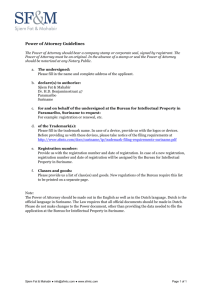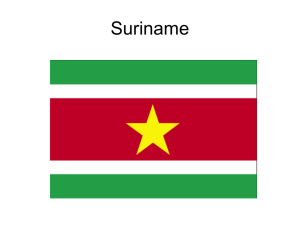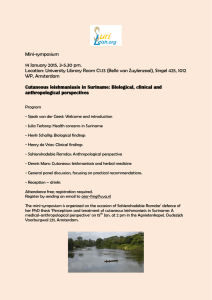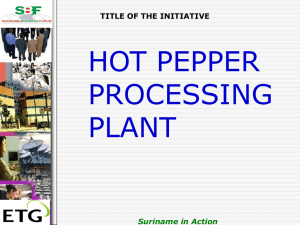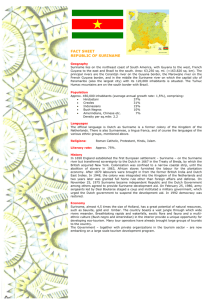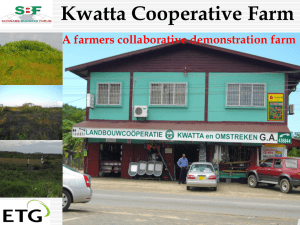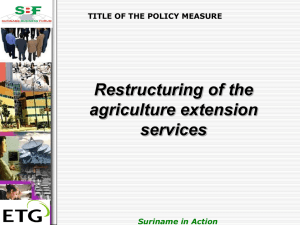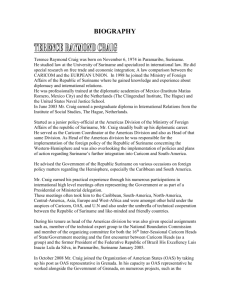Suriname: Improving Access to Finance for SMEs
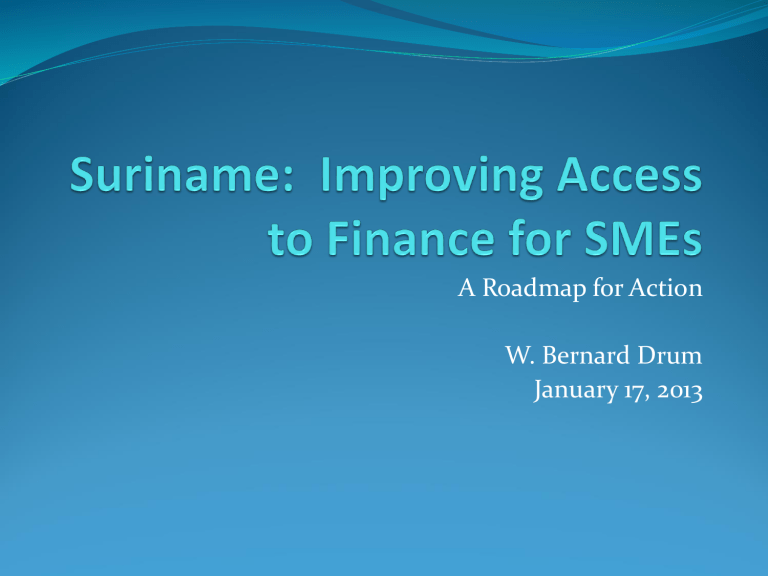
A Roadmap for Action
W. Bernard Drum
January 17, 2013
Purpose of Today’s Meeting
Briefly summarize the findings and recommendations from the recent study on access to finance for SMEs in
Suriname
Obtain feedback on the study report from a small group of important stakeholders. This will help in preparing a final version of the report for wider dissemination
Identify areas of consensus and establish priorities for action
Identify concrete next steps
The Study
Initiated in September 2012 by CUS in the Office of the
Vice President, with the support of IDB’s Compete
Caribbean Project
Work done by consultant W. Bernard Drum with support from CUS staff
Consisted of (i) desk research and (ii) ten days of field research in Suriname in October 2012
Analysis and recommendations draw on Suriname specific findings and on international best practices
Suriname Economic Background
Solid economic growth of 4.4 percent since 2000
Fiscal surplus of 1 percent of GDP in 2011
Debt at low level of 17.6 percent of GDP
But economy highly dependent on commodity exports
Economic diversification is a top priority
Large companies dominate in mining, banking, agroprocessing and trade
Private sector includes up to 20,000 SMEs, mainly in retail, trade, transportation and services
More than 25 percent of workforce employed by Govt.
Suriname Business Environment
Recent Reports
GEF Global Competitiveness Report 2012-2013
World Bank/IFC Doing Business Report 2013
World Bank Enterprise Survey 2010
Compete Caribbean Private Sector Assessment
Report 2012
Main Findings of these Recent reports
GCI ranks Suriname 114 out of 144 countries
Main constraints
government bureaucracy
corruption
access to finance
Doing Business ranks Suriname 164 out of 185 countries
Main areas of poor performance are
protecting investors, enforcing contracts, starting a business, registering property getting credit
resolving insolvency
Main Findings of these Recent
Reports (continued)
WB Enterprise Survey cites the top three constraints experienced by Suriname enterprises as
Inadequately educated workforce
Customs and trade regulations
Access to finance
Compete Caribbean PSAR cites the need to improve
Access to finance
Property rights
Transaction costs for trade
Labor markets
Priorities identified to improve the business environment
Identify and target priority sectors for development promote clusters, linkages, innovation and new technologies
Strengthen the institutional framework for competitiveness including improved interagency coordination, public private dialogue and investment promotion
Implement business regulatory reform
Target MSMEs for development, strengthen MSME skills and business associations
Improve the corporate tax structure
Improve corporate governance
Improve access to finance, especially for SMEs (identified as a key constraint in all the reports)
Banking sector performance
Good performance on capital adequacy (12 per cent), return on assets (1.9 percent) and return on equity (27 percent)
Ongoing proactive measures by the Central Bank to improve supervision
Deposits are around 51 percent of GDP – near the regional average
Interest rate spreads around 5 percent for local currency – near or below the regional average
But credit to the private sector is only 23 percent of GDP, and Suriname ranks as one of the lowest in the region on this criterion
Banking sector structure and infrastructure
Sector is highly concentrated with 80 percent of assets in top three banks
State ownership predominates
No formal credit information sharing mechanism
No movable assets registry
Clearing and settlement and POS/ATM infrastructure relatively well developed
NBFS not significant as a source of finance for business with the exception of informal lending
State Sponsored Credit Lines
A number of internationally financed credit lines have been extended through the commercial banks over the last 30 years, in many cases with NOB as the apex institution
Anecdotal evidence is that the performance of these credit lines, particularly the earlier ones, was mixed
Recent announcements of trade guarantees for SMEs through DSB
Plans are on the table for setting up a partial credit guarantee scheme
Main Access to Finance
Impediments Identified in the
Study
Central Bank reserve requirements – 25 percent for domestic currency and 40 percent for forex
Loans secured mainly by real estate – no movable assets registry or developed secured transactions regime
Lack of a formal credit information sharing or reporting mechanism
Historical focus of the commercial bank lending on larger borrowers
Inadequate financial reporting regulations and practices in
Suriname continued
Main access to finance impediments identified in the study (continued)
Lack of skills in SMEs in the preparation of business plans and loan proposals
Weaknesses in the investor protection regime that impede the development of the capital markets
Little use of leasing or factoring and the absence of an enabling environment to encourage the use of these instruments
Little or no venture capital available
Recommendations
Create a private credit bureau
Independent ownership
Comprehensive sharing of all credit information
Wide coverage of credit sources
Use internationally available expertise
Consult fully with the public to ensure success
Continued:
Recommendations (continued)
Strengthen the secured transactions regime and create a movable assets registry
Review the legal framework governing property rights and collateral and make changes where necessary
Design and implement a collateral registry
to cover all movable pledged collateral in Suriname
Limit information to security interests
Online and accessible at all times
Secure
Subject to data entry by registrants
Recommendations (continued)
Strengthen accounting and auditing rules and standards
Draft an Accountancy Act to include institutional and accounting reforms
Strengthen capacity of SUVA and improve training of accountants
Establish a Securities and Exchange Commission and continue to improve Central Bank supervision
Phase in new reporting requirements at a rate compatible with development of accounting capacity
Recommendations (continued)
Support training of entrepreneurs in business planning and loan proposals
Engage all stakeholders and complete a study of supply and demand
Avoid generic training and focus on specific needs
Delivery it in a market friendly way through private providers
Ensure cost recovery through beneficiary contributions
Apply rigorous monitoring to ensure desired targeting
Recommendations (continued)
Support training of bankers in SME lending
Assess supply and demand for such training and determine its scope
Select an institution to deliver it
Likely focus will be on SME lending skills such as:
Risk appraisal and management
Loan products and pricing
Collections
Information systems
Compensation and incentives for loan officers
Recommendations (continued)
Develop additional sources of finance and financing instruments
To promote the stock market complete a review and update corporate governance laws, regulations and practices
Create a new code of good corporate governance
Improve financial disclosure
Enhance the roles and compositions of boards of directors
Increase CEO and director accountability
Enact a new capital markets law
Review and improve legislation impacting the creation of venture capital companies
Review the laws and tax rules governing leasing and factoring
Recommendations (continued)
Complete a detailed cost benefit analysis of current proposals for a credit guarantee facility. If a decision is taken to go ahead:
Establish monitoring and evaluation criteria in advance and apply them rigorously
Building of capacity, particularly risk management skills, within lending institutions should be a major objective
Maximize involvement of private institutions in implementation
Central Bank should supervise the operation
Beneficiaries should be SMEs who should be required to provide collateral or other security
Participating financial institutions should be required to cover a share of the risks
